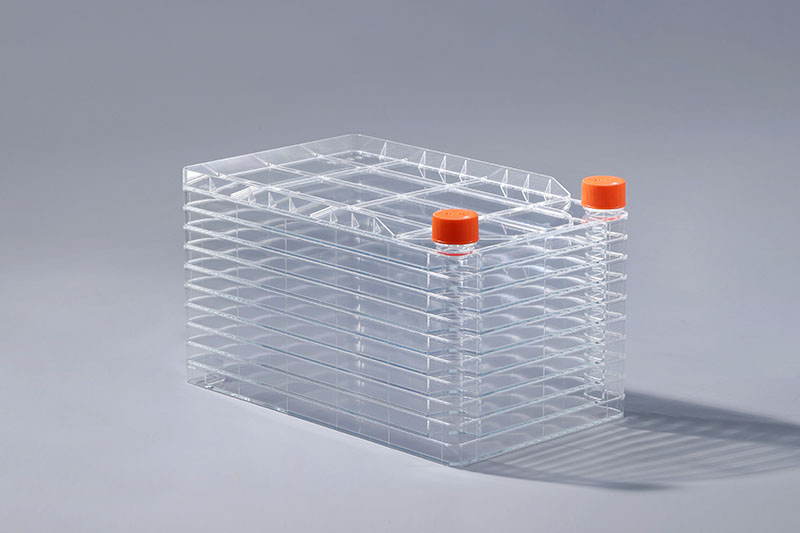عبارة عن هيكل متعدد الطبقات من مستهلكات زراعة الخلايا ، والتي تتميز بمزايا منطقة الاستزراع الكبيرة ، واحتلال مساحة نباتية صغيرة ، ودرجة تلوث منخفضة. من أجل ضمان جودة المنتج ، يلزم إجراء العديد من الاختبارات ، واختبار البكتيريا المسببة للتلوث الأولي هو أحدها. المنتج المراد تعقيمه. إنه اختبار حد جرثومي ، والذي يشير إلى درجة التلوث الجرثومي للمنتجات والمواد الخام المعقمة غير المحددة والمواد المساعدة والمنتجات النهائية قبل التعقيم ، بما في ذلك كمية التلوث والبكتيريا المكافحة. ، أي عدد المستعمرات المعتاد ، فحص البكتيريا المسببة للأمراض والقولون. الغرض من هذا الاختبار هو توفير مؤشر مرجعي للتعقيم التالي لمصنع الخلية ، مثل جرعة التعقيم ، وذلك لضمان تأثير التعقيم. يمكن القول أنه اختبار لرصد فعالية عملية التعقيم. To باختصار ، الغرض من الكشف الأولي عن البكتيريا الملوثة في مصنع الخلايا هو تأكيد جرعة التعقيم ، ومراقبة فعالية عملية التعقيم ، وبالتالي ضمان عقم المنتج. لتحليل العبء الحيوي ، تم سحب ما لا يقل عن 10 عينات من ثلاث مجموعات منفصلة من المنتج للاختبار. يجب إجراء تحليل الحِمل الحيوي وفقًا لطريقة مُعتمدة ومتاحة. تم حساب متوسط الحمولة الحيوية لكل دفعة واستخدم متوسط الحِمل الحيوي المكون من 30 عينة كمتوسط إجمالي للحمل الحيوي للدفعات الثلاث. إذا كان متوسط الحِمل الحيوي لإحدى الدُفعات الثلاث أكبر مرتين أو أكثر من إجمالي متوسط الحِمل الحيوي ، فسيتم استخدام متوسط الدُفعات للتحقق من الجرعة ، وإلا فسيتم استخدام المتوسط العام للدفعات الثلاث للتحقق من الجرعة.
Generally speaking, the initial contamination bacteria test is the estimated value of the bioburden of the product to be sterilized. It is a microbial limit test, which refers to the degree of microbial contamination of non-specified sterilized products and raw materials, auxiliary materials and finished products before sterilization, including the amount of contamination and control bacteria. , that is, the usual colony count, coliform and pathogenic bacteria inspection. The purpose of this test is to provide a reference index for the next sterilization of the cell factory, such as the sterilization dose, so as to ensure the sterilization effect. It can be said to be a test to monitor the effectiveness of the sterilization process.
For bioburden analysis, at least 10 samples were drawn from three separate batches of product for testing. Bioburden analysis must be performed according to a validated and available method. The average bioburden of each batch was calculated and the average bioburden of 30 samples was used as the total average bioburden of the three batches. If the average bioburden of one of the three batches is two or more times greater than the total average bioburden, the batch average is used for dose verification, otherwise, the overall average of the three batches is used for dose verification.
To sum up, the purpose of the initial contaminating bacteria detection in the cell factory is to confirm the sterilization dose, monitor the effectiveness of the sterilization process, and thus ensure the sterility of the product.
The FAI climbed 5.9 percent year-on-year in the first 11 months of 2018, quickening from the 5.7-percent growth in Jan-Oct, the National Bureau of Statistics (NBS) said Friday in an online statement.
The key indicator of investment, dubbed a major growth driver, hit the bottom in August and has since started to rebound steadily.
In the face of emerging economic challenges home and abroad, China has stepped up efforts to stabilize investment, in particular rolling out measures to motivate private investors and channel funds into infrastructure.
Friday's data showed private investment, accounting for more than 60 percent of the total FAI, expanded by a brisk 8.7 percent.
NBS spokesperson Mao Shengyong said funds into weak economic links registered rapid increases as investment in environmental protection and agriculture jumped 42 percent and 12.5 percent respectively, much faster than the average.
In breakdown, investment in high-tech and equipment manufacturing remained vigorous with 16.1-percent and 11.6-percent increases respectively in the first 11 months. Infrastructure investment gained 3.7 percent, staying flat. Investment in property development rose 9.7 percent, also unchanged.
 English
English



















































